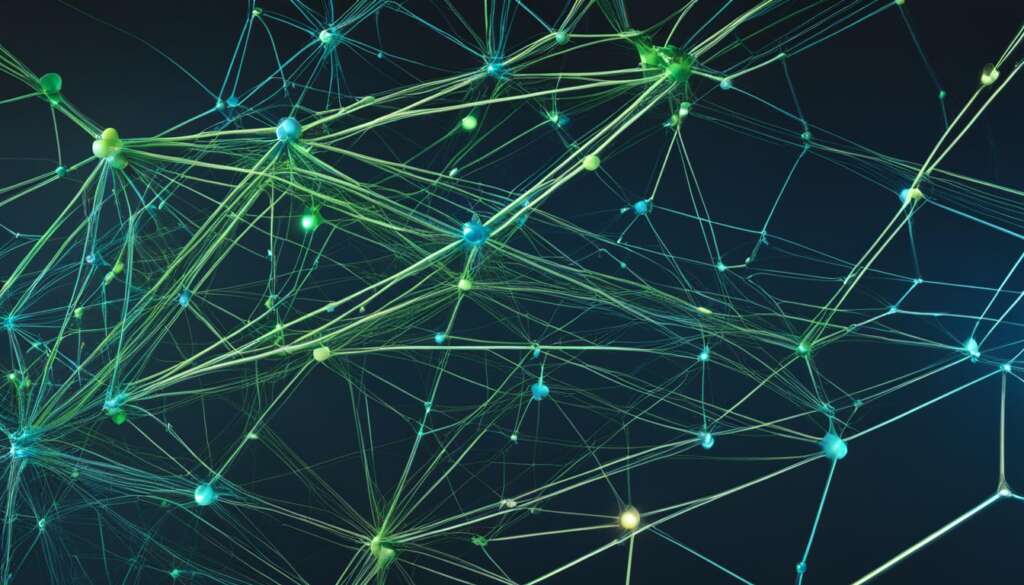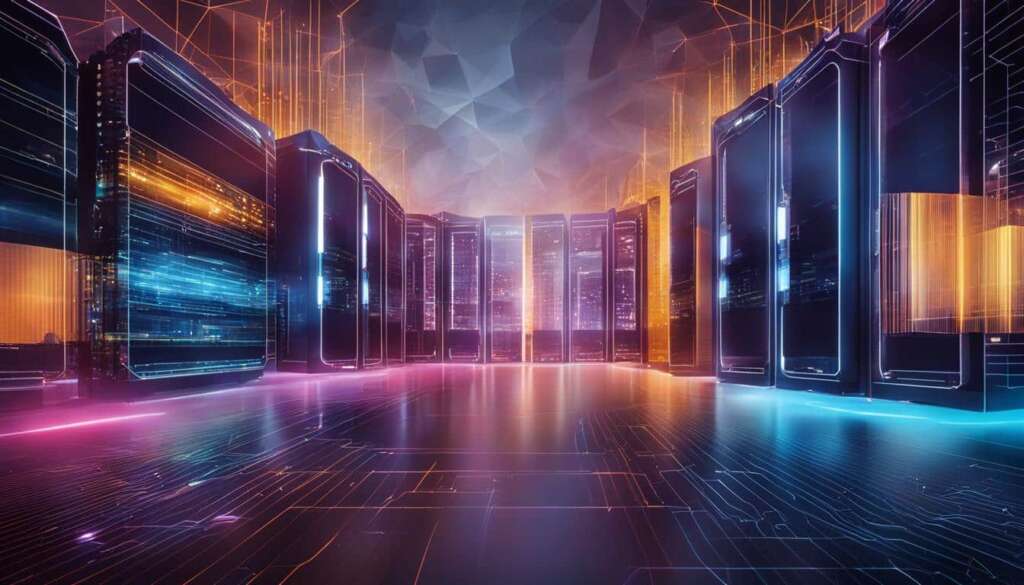Table of Contents
Grid computing has revolutionized the world of distributed computing, enabling multiple machines to collaborate and function as a virtual supercomputer. With the ability to handle compute-intensive tasks that single machines often struggle with, grid computing offers a powerful solution for organizations in need of high-performance computing capabilities.
In this article, we will delve into the fundamentals of grid computing, including its architecture, key components, and diverse applications. Whether you are in the fields of finance, entertainment, engineering, or any other industry that relies on data processing, grid computing technology holds immense potential for optimizing your computing resources and driving innovation.
Throughout this article, we will explore various aspects of grid computing, including parallel computing, cluster computing, and grid infrastructure. We will also delve into the grid computing framework and its applications in different industries. Whether you are familiar with grid computing or just beginning to explore its capabilities, this article will provide you with valuable insights into this cutting-edge technology.
What Is Grid Computing?
Grid computing is a distributed architecture of multiple computers connected by networks to accomplish a joint task. It harnesses the power of collaboration, allowing multiple machines to work together as a virtual supercomputer. This distributed approach enables grid computing to handle compute-intensive tasks that would be challenging for a single machine to handle alone.
Grid computing provides seamless access to IT capabilities, creating a unified system image for efficient resource utilization. By leveraging the distributed architecture and pooling resources, grid computing transforms individual computers into a powerful network capable of tackling complex tasks.
Grid computing enables the seamless collaboration of multiple machines, working together as a virtual supercomputer.
Grid computing has revolutionized the way we utilize computational resources. It provides a scalable and flexible solution that optimizes computing power and enhances performance. Whether it’s processing big data, running simulations, or solving complex problems, grid computing harnesses the collective power of distributed systems.
In the next section, we will explore how grid computing works and the key components that make it possible.
How Grid Computing Works
In a grid computing network, there are three main machine types. The control node/server administers the network and maintains the resource pool. The provider/grid node contributes resources to the pool, while the user utilizes the resources to complete tasks. Specialized software coordinates and manages the tasks, breaking them down into subtasks assigned to each computer. The software enables communication and information sharing among the computers, allowing for the consolidation of outputs to complete the main task. Grid computing utilizes a distributed architecture and parallel processing to achieve efficient execution.

Key Components of Grid Computing
A grid computing environment comprises several essential components that make it possible to harness the power of distributed computing. These components work together seamlessly to ensure efficient task execution and resource management.
User Interface: The user interface provides users with a unified and intuitive view, enabling them to access and launch applications on the grid. It serves as an entry point, simplifying the interaction between users and the grid computing system.
Security: Security mechanisms play a critical role in protecting grid computing resources and data. Authentication and encryption protocols provide secure access to the grid, ensuring only authorized users can utilize its capabilities. By implementing robust security measures, grid computing environments safeguard sensitive information and defend against unauthorized access.
Scheduler: The scheduler is responsible for coordinating task scheduling and execution across the grid nodes. It ensures that tasks are assigned to the appropriate resources and executed efficiently. By effectively managing the allocation of computing resources, the scheduler optimizes task execution and minimizes resource wastage.
Data Management: Data management is a crucial component of grid computing that enables the movement and accessibility of data within the grid. It involves storing, organizing, and retrieving data to support efficient computation and collaboration. Effective data management ensures that data is available when needed, enhancing the overall performance of grid computing systems.
Workload & Resource Management: Workload and resource management are integral to achieving optimal performance in grid computing environments. This component involves the allocation and monitoring of resources to ensure that tasks are executed efficiently. By effectively distributing workloads and managing available resources, grid computing systems can maximize their computing capabilities.
These key components collectively contribute to the seamless operation and performance of grid computing environments. They form the foundation for harnessing the full potential of distributed computing and enabling the execution of complex tasks with speed and efficiency.
Types of Grid Computing With Examples
Grid computing encompasses various types that cater to different applications. Each type optimizes the power of distributed computing to achieve specific goals. Let’s explore the three prominent types of grid computing:
1. Computational Grid Computing
Computational grid computing is focused on breaking down complex tasks into smaller subtasks, allowing for parallel processing across multiple nodes. By distributing the workload, computational grid computing enhances performance and enables faster execution of computationally intensive operations.
An example of computational grid computing is the SETI@home project. It utilizes idle computing resources from volunteers worldwide to analyze radio signals from space, aiding the search for extraterrestrial intelligence. By harnessing the collective power of thousands of computers, SETI@home performs complex calculations that would be impractical for individual machines.
2. Data Grid Computing
Data grid computing emphasizes the distribution, storage, and access of data across multiple nodes. It enables simultaneous collaboration and sharing within a grid environment, facilitating efficient data processing and analysis.
A notable example of data grid computing is the Large Hadron Collider (LHC) at CERN. The LHC generates an enormous amount of data from particle collisions, requiring distributed data storage and analysis. Grid computing allows scientists worldwide to access and process this data, contributing to groundbreaking discoveries in particle physics.
3. Collaborative Grid Computing
Collaborative grid computing focuses on supporting seamless collaboration among users within a grid environment. It integrates various technologies to enable real-time communication, resource sharing, and collaborative work on shared tasks.
One example of collaborative grid computing is the Folding@home project. It aims to understand protein folding and how misfolding leads to diseases like Alzheimer’s and cancer. Volunteers around the world donate their computing resources to simulate protein folding, contributing to medical research and the development of new treatments.
In summary, the three types of grid computing – computational grid computing, data grid computing, and collaborative grid computing – serve different purposes and address specific challenges. By harnessing the power of distributed computing, these types enable efficient parallel processing, data management, and collaborative work, revolutionizing various industries.
Now, let’s take a deeper look at these types of grid computing and their applications with examples in the following table:
| Type of Grid Computing | Definition | Example with Applications |
|---|---|---|
| Computational Grid Computing | Breaking down complex tasks into subtasks for parallel processing | SETI@home – Analyzing radio signals from space |
| Data Grid Computing | Distributed data storage and access for collaboration and analysis | Large Hadron Collider (LHC) – Processing particle collision data |
| Collaborative Grid Computing | Enabling seamless collaboration and resource sharing among users | Folding@home – Simulating protein folding for medical research |
By understanding these types of grid computing and their applications, organizations can leverage the power of distributed computing to optimize performance, enhance data management, and foster collaborative innovation.

Conclusion
Grid computing offers a powerful solution for handling compute-intensive tasks by leveraging the distributed architecture of multiple computers. With grid computing, resources are pooled and parallel processing is enabled, resulting in efficient and faster execution of complex tasks. This approach creates a virtual supercomputer that seamlessly integrates machines across networks, revolutionizing data processing and collaborative work.
The applications of grid computing span across various industries, including financial services, gaming, entertainment, and engineering. By harnessing the flexible and scalable nature of grid computing, organizations can optimize their computing resources and drive innovation. The distributed architecture and resource pooling capabilities of grid computing make it a game-changer, enabling the processing of massive amounts of data and facilitating collaboration among users.
Grid computing enables businesses to tackle complex computational challenges by breaking them down into smaller subtasks that can be processed in parallel. This parallel processing technique not only enhances performance but also reduces time-to-solution, making it an invaluable asset for organizations with high computing demands. With grid computing, the possibilities are limitless, and the potential for achieving breakthroughs in various fields is immense.
FAQ
What is grid computing?
Grid computing is a distributed architecture of multiple computers connected by networks to accomplish a joint task. It enables the seamless collaboration of multiple machines, working together as a virtual supercomputer to tackle compute-intensive tasks that would be challenging for a single machine.
How does grid computing work?
In a grid computing network, there are three main machine types. The control node/server administers the network and maintains the resource pool. The provider/grid node contributes resources to the pool, while the user utilizes the resources to complete tasks. Specialized software coordinates and manages the tasks, breaking them down into subtasks assigned to each computer. The software enables communication and information sharing among the computers, allowing for the consolidation of outputs to complete the main task.
What are the key components of grid computing?
A grid computing environment consists of several key components. The user interface provides a unified view for users to access and launch applications on the grid. Security mechanisms, such as authentication and encryption, ensure the protection of resources and data. A scheduler coordinates task scheduling and execution across the grid nodes, while data management enables the movement and accessibility of data within the grid. Workload and resource management facilitate the allocation and monitoring of resources for efficient task execution.
What are the types of grid computing?
Grid computing can be categorized into different types based on its applications. Computational grid computing involves breaking down complex tasks into subtasks, allowing parallel processing across multiple nodes for faster execution. Data grid computing focuses on distributed data storage and access, enabling simultaneous collaboration and sharing. Collaborative grid computing facilitates seamless collaboration among users, utilizing various technologies to support collaborative work.
How can grid computing benefit industries?
Grid computing offers a powerful solution for handling compute-intensive tasks by leveraging the distributed architecture of multiple computers. By pooling resources and enabling parallel processing, grid computing allows for efficient and faster execution of complex tasks. It provides a virtual supercomputer that seamlessly integrates machines across networks, revolutionizing data processing and collaborative work. Grid computing has various applications across industries, including financial services, gaming, entertainment, and engineering. With its flexible and scalable nature, grid computing holds immense potential for optimizing computing resources and driving innovation.












